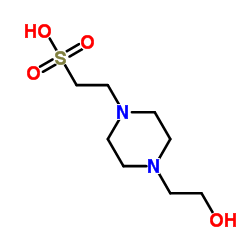HEPES

HEPES structure
|
Common Name | HEPES | ||
|---|---|---|---|---|
| CAS Number | 7365-45-9 | Molecular Weight | 238.305 | |
| Density | 1.3±0.1 g/cm3 | Boiling Point | N/A | |
| Molecular Formula | C8H18N2O4S | Melting Point | 234-238 °C | |
| MSDS | Chinese USA | Flash Point | N/A | |
Use of HEPESHEPES, a zwitterionic chemical buffering agent, is broadly applied in cell culture. HEPES is effective at pH 6.8 to 8.2. HEPES is a potent inducer of lysosome biogenesis[1][2][3]. |
| Name | 2-[4-(2-hydroxyethyl)piperazin-1-yl]ethanesulfonic acid |
|---|---|
| Synonym | More Synonyms |
| Description | HEPES, a zwitterionic chemical buffering agent, is broadly applied in cell culture. HEPES is effective at pH 6.8 to 8.2. HEPES is a potent inducer of lysosome biogenesis[1][2][3]. |
|---|---|
| Related Catalog | |
| References |
[2]. Sledź P, et al. An experimental charge density of HEPES. Acta Crystallogr B. 2010;66(Pt 4):482-492. |
| Density | 1.3±0.1 g/cm3 |
|---|---|
| Melting Point | 234-238 °C |
| Molecular Formula | C8H18N2O4S |
| Molecular Weight | 238.305 |
| Exact Mass | 238.098724 |
| PSA | 89.46000 |
| LogP | -2.67 |
| Index of Refraction | 1.543 |
| Storage condition | 2-8°C |
| Stability | Stable. Combustible. Incompatible with strong oxidizing agents. Protect from moisture. |
| Water Solubility | Soluble |
CHEMICAL IDENTIFICATION
HEALTH HAZARD DATAACUTE TOXICITY DATA
|
| Personal Protective Equipment | Eyeshields;Gloves;type N95 (US);type P1 (EN143) respirator filter |
|---|---|
| Hazard Codes | Xi: Irritant; |
| Risk Phrases | R36/37/38 |
| Safety Phrases | S24/25-S22-S36-S26 |
| RIDADR | NONH for all modes of transport |
| WGK Germany | 1 |
| RTECS | TL6809000 |
| HS Code | 29335995 |
| HS Code | 29335995 |
|---|
|
Epigenetic reprogramming of the type III interferon response potentiates antiviral activity and suppresses tumor growth.
PLoS Biol. 12(1) , e1001758, (2014) Type III interferon (IFN-λ) exhibits potent antiviral activity similar to IFN-α/β, but in contrast to the ubiquitous expression of the IFN-α/β receptor, the IFN-λ receptor is restricted to cells of ep... |
|
|
Functional consequence of the MET-T1010I polymorphism in breast cancer.
Oncotarget 6(5) , 2604-14, (2015) Major breast cancer predisposition genes, only account for approximately 30% of high-risk breast cancer families and only explain 15% of breast cancer familial relative risk. The HGF growth factor rec... |
|
|
Immunomodulation by the Pseudomonas syringae HopZ type III effector family in Arabidopsis.
PLoS ONE 9(12) , e116152, (2014) Pseudomonas syringae employs a type III secretion system to inject 20-30 different type III effector (T3SE) proteins into plant host cells. A major role of T3SEs is to suppress plant immune responses ... |
| 4-(2-hydroxyethyl)-1-piperazineethanesulfonic acid |
| hepesfreeacid |
| 4-(2-Hydroxyethyl)piperazine-1-ethanesulfonic acid |
| HEPES.1/2Na |
| 2-[4-(2-hydroxyethyl)piperazin-1-yl]ethanesulfonic acid |
| EIT hydrobromide |
| hepes solution |
| 1-Piperazineethanesulfonic acid, 4-(2-hydroxyethyl)- |
| 4-(2-hydroxyethyl)-1-piperazineethanesulphonic acid |
| GOOD'S BUFFER |
| HEPES |
| HEPES BUFFER PH 8.0 |
| 2-[4-(2-Hydroxyethyl)-1-piperazinyl]ethanesulfonic acid |
| EINECS 230-907-9 |
| HEPES,1M solution |
| MFCD00006158 |

